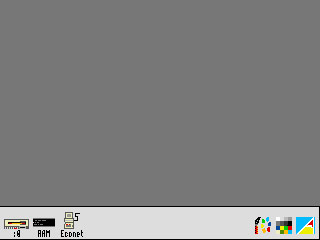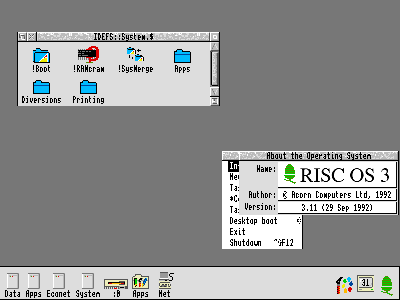RISC OS
What is RISC OS
RISC OS is the operating system that is used to power most Archimedes computers. It has a single tasking kernel with co-operative multi-tasking being provided to the operating system by the WindowManager module. Traditionally, RISC OS was provided on ROMs with Arthur and RISC OS 2 having 512KB of ROM and RISC OS 3 using 2MB of ROM.
Arthur, the origins of RISC OS
When RISC OS originally shipped with the A300 and original A400 series Archimedes, it wasn't called RISC OS at all. Instead it was called "Arthur" the meaning of which has been lost to the mists of time. When Acorn were working on the second generation of Arthur, its name was changed as it was felt that the name of the operating system would clash with the Hollywood film "Arthur 2" starring Dudley Moore and so the first version of RISC OS to be released was RISC OS 2.
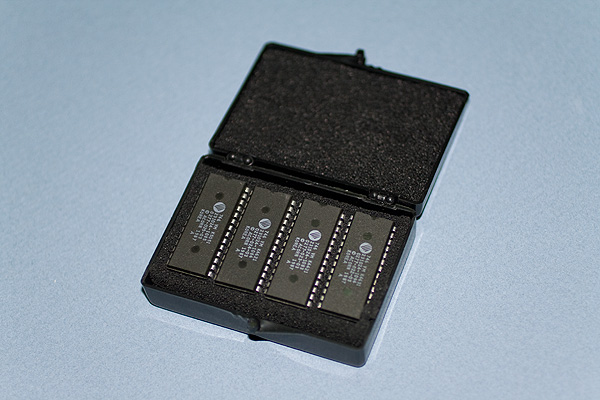
In June 2013 I tested my Arthur ROMs by fitting them to my Archimedes A310 and here's the obligatory Arthur desktop photo. You can tell it's not an emulated screenshot because of the 15kHz monitor and the Econet icon down in the left hand corner of the Icon Bar indicating the A310 has an Econet card installed.
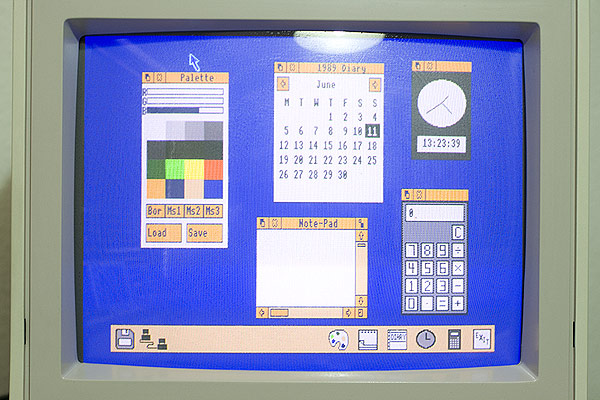
RISC OS 2
RISC OS 2 was released as the operating system for the A400/1 series of Archimedes and the BBC Acorn A3000. It delivered huge improvements in stability and usability over the original Arthur operating system.
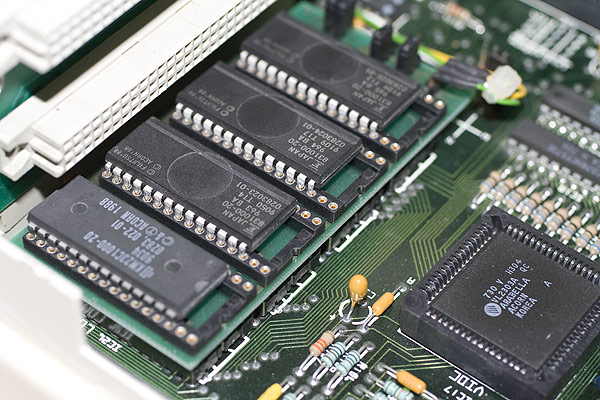
RISC OS 2 was the first operating system that I personally used that had a WIMP based GUI.
RISC OS 3
RISC OS 3 was released with the launch of the Acorn A5000 and was made available as a ROM upgrade to owners of older Archimedes computers. It could easily be fitted to Archimedes models such as the 400/1 series and A3000. The original A300 and A400 series required a daughter board to provide space for the RISC OS 3 ROMs to be fitted.
RISC OS 3 added better support for multi-tasking and a much larger API which applications could use to exploit the new features that RISC OS 3 provided.
RISC OS 3.00 was delivered with some serious bugs and was quickly replaced with RISC OS 3.10. RISC OS 3.10 was again replaced after a relatively short period with RISC OS 3.11 which addressed a minor issue with the way in which the serial port communications worked.
RISC OS 3.11 was the last version of RISC OS to support the older Archimedes hardware and is widely regarded as being the most compatible version of the operating system with both older software and more modern software as it is capable of supporting most RISC OS 2 software and can also run 26/32-bit neutral software that is designed to be compatible with later versions of RISC OS including even the latest versions of RISC OS that can run on the Beagle Board and the Raspberry Pi.
RISC OS for the RISC PC and beyond
Later, Acorn released the RISC PC with RISC OS 3.5 and later RISC OS 3.6 which supported a new hardware model and as such could not be retro-fitted to the older Archimedes ranges.
With the demise of Acorn in 2000, RISC OS continued to be developed and its development was forked by Castle Technology and RISC OS Ltd which has produced much confusion to outsiders.
RISC OS Ltd developed RISC OS 4 which could be installed into RISC PC's and later revisions could be soft-loaded over the original RISC OS 4 ROMs. In the meantime, Castle Technology developed a fully 32-bit version of RISC OS called RISC OS 5.
RISC OS 5 introduced incompatibilities with older versions of RISC OS as it did not support the old 26-bit addressing architecture.
Throughout this time, RISC OS Ltd continued to develop their fork of RISC OS and later released RISC OS 6 which again could be soft loaded onto the older Acorn RISC PC's.
This situation means that RISC OS 5 is technically the more advanced version of RISC OS (being a pure 32-bit architecture) even though on the face of it, it is one version behind and it lacks some of the features that have been built into RISC OS 4 and 6.
With the demise of RISC OS Ltd in early 2013, the future of RISC OS 4 and 6 is uncertain to say the least and currently, RISC OS 5 is the only branch of RISC OS being developed through a shared source initiative instigated by Castle Technology Ltd. Versions of RISC OS 5 are available for the BeagleBoard and Raspberry Pi amongst other ARM based hardware devices. The shared source initiative is managed by RISC OS Open Ltd (ROOL).
Given the situation with the RISC OS Ltd and ROOL meaning there is now only one version of RISC OS being actively developed coupled the boost in interest around RISC OS that has happened since the Raspberry Pi was launched in 2012, the future of RISC OS hasn't looked so good in ages.
Translate this site
Acorn BBC Archimedes A310
Acorn Archimedes A400/1
Acorn BBC A3000
Acorn A5000
POST error calculator
Acorn RISC computer fault codes are reported via the flashing of the floppy drive light in a sequence of 8 blocks of 4 flashes. Each block of four flashes (e.g. long short short long) represents a set of fault and status bits which can be translated into a list of error codes.
Select the boxes that represent the long flashes from your computer to derive the fault code and its translation.
Fault code:
RISC OS - POST values
Common hardware failures
RISC OS Rambles
Articles covering a range of topics all about the development of RISC OS from one of its developers Justin Fletcher. Well worth the read!
IconBar posts
News
- RISC OS continues to grow on GitHub
- Archive magazine updates
- Wakefield 2022 will go ahead on Saturday 21st May
- Drag'n'Drop 11i2 edition reviewed
- RISCOSbits releases some more risque hardware
Forums
- RISCOSbits releases some more risque hardware
- Is BASIC still useful for coding?
- Is BASIC still useful for coding?
- Three RISC OS Show dates for your 2022 diary
- Iris Web Browser receives January update
provided courtesy of The IconBar
